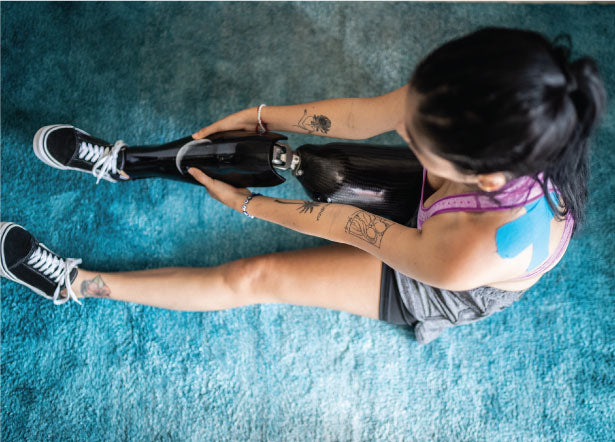HOLO Suspension System vs. Other Suspension Systems
When it comes to ensuring comfort and mobility among prosthetic users, a sound prosthetic suspension system is the key. A study looked into the difference between the HOLO (hook and loop) suspension system and other existing systems—magnetic, pin/lock, and suction.

Prosthetic sockets and suspension systems are considered the most critical components of a prosthetic limb as these are in direct contact with the residual limb. Therefore, excessive rotation, vertical movements, and translation between the socket and the residual limb should be mitigated or prevented by the suspension system.
Researchers conducted the study in the University of Malaya Medical Centre in Kuala Lumpur, Malaysia, with nine below-knee study participants. The research team tested the durability and comfort of each suspension system.
Durability, movement between socket and liner
The research team needed to determine how durable each suspension system is, as well as the movement between the socket and the silicone liner. The researchers used the INSTRON 4466 universal testing machine to test how much tensile force the suspension systems could tolerate before failing. Meanwhile, the NorthPlex 12mm was used to check the movement between the socket and liner during the tensile loading test.
In a typical use case, suspension systems bear 30 to 50 N when walking. The HOLO system could tolerate 490 N.
The tensile strength test showed that the HOLO system could tolerate a maximum load of 490 Newtons (N)—almost ten times more than the applied load in normal walking. Meanwhile, researchers found the liner and the socket movement to be only 4mm during 30 seconds of tensile loading.
The pin/lock suspension system could tolerate 580 N, more than the HOLO system, but it lost its function after three trials. The system showed no movement between the socket and the end of the prosthetic liner, but 18 mm of traction in the silicone liner was recorded.
The magnetic (MPSS) could tolerate a load of 150.9 N and showed 12 mm of traction in the silicone liner. Meanwhile, the suction system could handle 310 N. About 7 mm of movement between the socket and the liner was detected before the system failed.
In a typical use case, suspension systems bear a 30 N to 50 N load when walking. The tests showed that a prosthetic limb could be made lighter with the HOLO system. In comparison, the suction, pin/lock, and magnetic suspension systems were heavier than the HOLO by 3%, 11.1%, and 15.3%, respectively.
A prosthetic limb could be lighter with the HOLO suspension system.
Compared to the pin/lock and magnetic systems, the HOLO suspension system recorded lesser movement between the prosthetic socket and silicone liner. This is because the liner socket walls (hook) and the liner (loop) were fully attached. The researchers also confirmed the mechanical test’s findings with the subjective study—little movement inside the socket has a significant effect on the function of the prosthetic limb and the user’s satisfaction.
Subjective test
Each study participant was given four below-knee prosthetic limbs with different suspension systems—HOLO, magnetic, suction, and pin/lock. They were also fitted with a transparent check socket.
First, they were asked to walk with their prosthetic limbs in the prosthetic laboratory located in the University of Malaya’s Department of Biomedical Engineering. This exercise allowed the participants to familiarize themselves with and adapt to the new prosthetic sockets. Then they were given a trial period of at least four weeks for each suspension system.
At the end of the trial period, the researchers found that the participants were generally pleased with the HOLO suspension system. There was also no significant difference between the magnetic and pin/lock suspension systems. Although the suction system made their prosthetic limbs feel like a natural part of their body.
There was no significant difference between HOLO and the other suspension systems when it came to walking, climbing stairs, sitting, swelling, and sweating.
The study participants were generally happier with the HOLO suspension system because it was easier to put on and remove. However, the participants found that it creates more sound—described as a tearing noise—than the other systems. The sound was made when the participants removed their prosthetic limbs.
The study participants were generally happier with the HOLO suspension system.
Conclusion
Limited use or rejection of prosthetic devices is one of the most common concerns of many amputees in the rehabilitation phase. This is why choosing an appropriate suspension system is vital for prosthetists. However, selecting a suspension system requires considering the patient’s functional needs and overall satisfaction with a particular prosthetic limb.
The study revealed that the HOLO suspension system is a good alternative for below- and above-knee prosthetic users as it could solve some problems with the other systems. The HOLO system provides numerous advantages for prosthetic users, including firm attachment to the prosthetic socket and easy donning and doffing. It is also lighter than the other suspension systems.
If you’re interested in trying the HOLO suspension system, please consult your prosthetist first.











































































